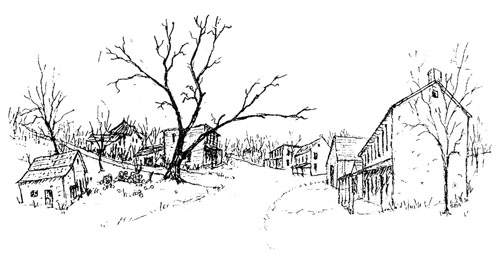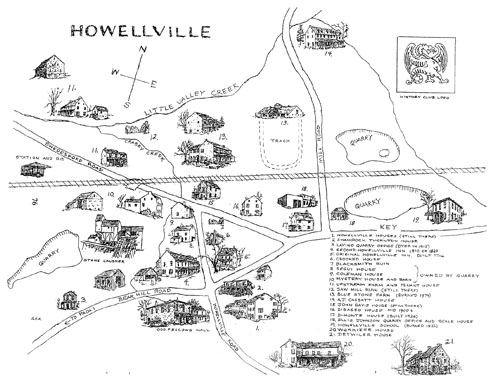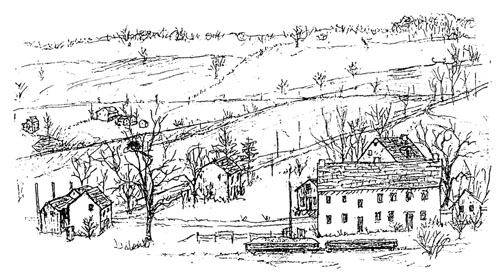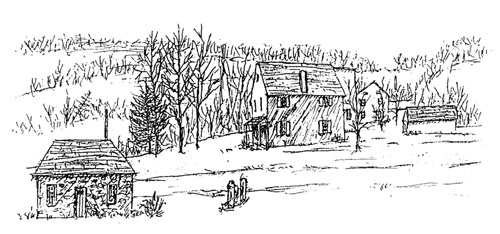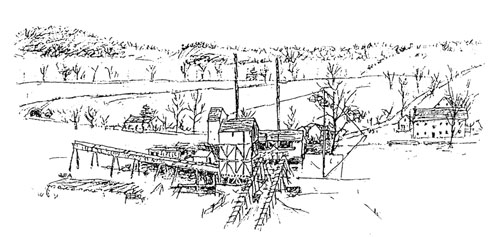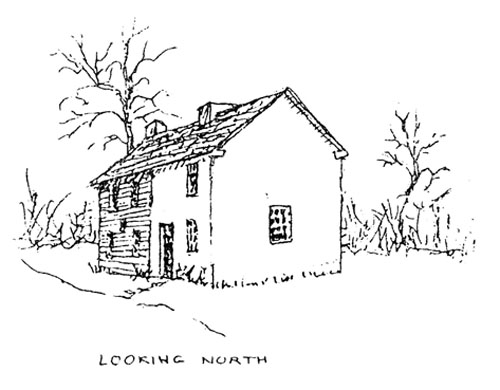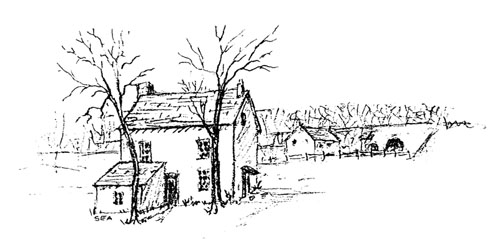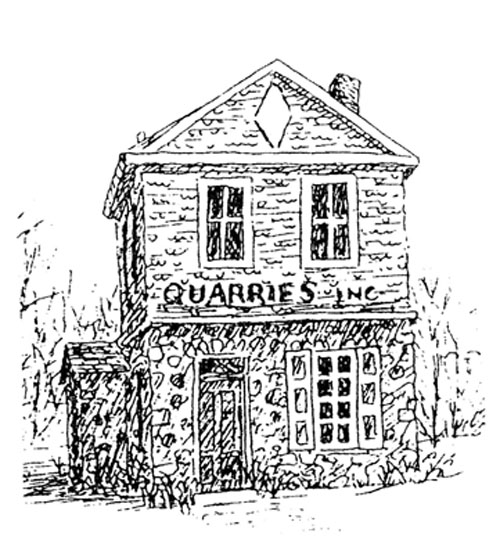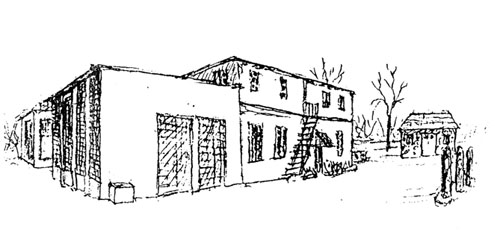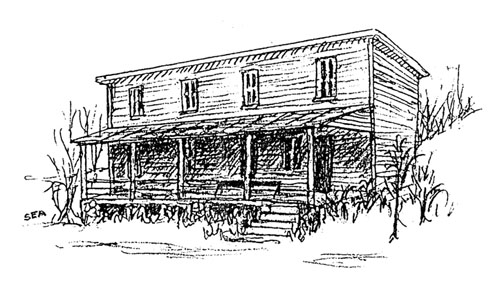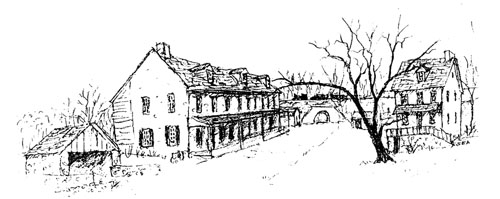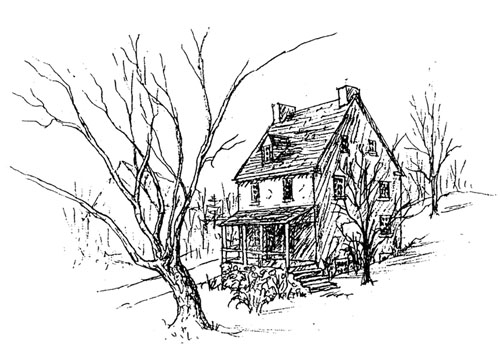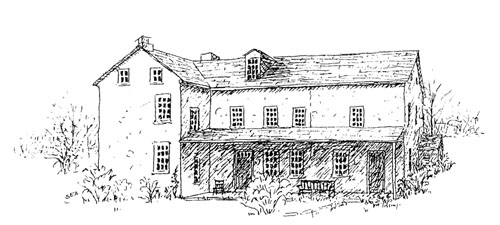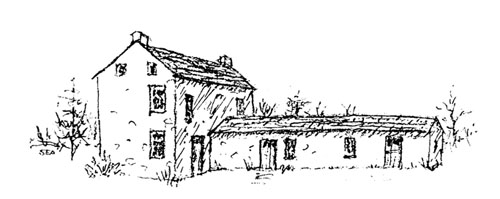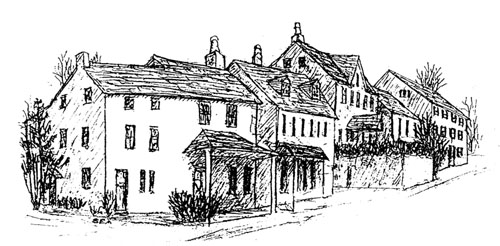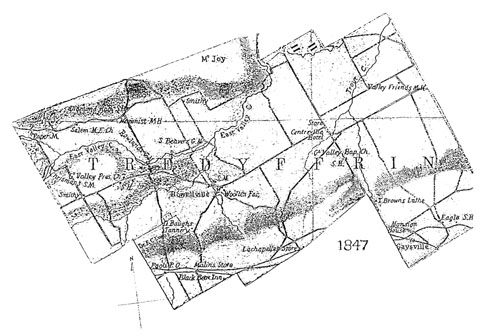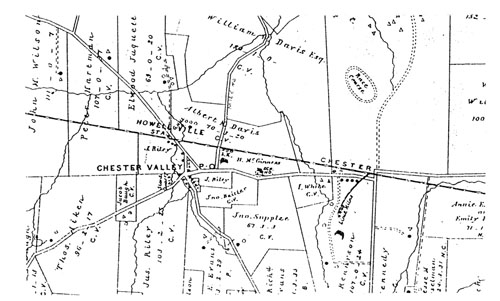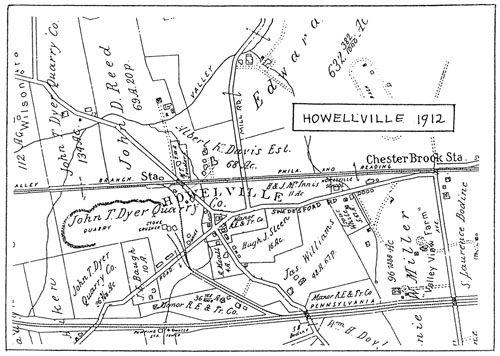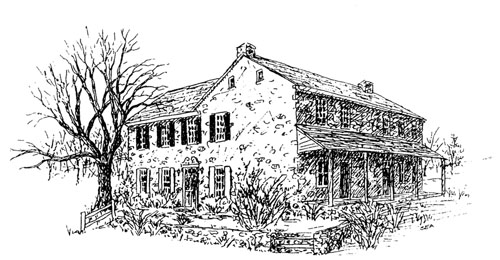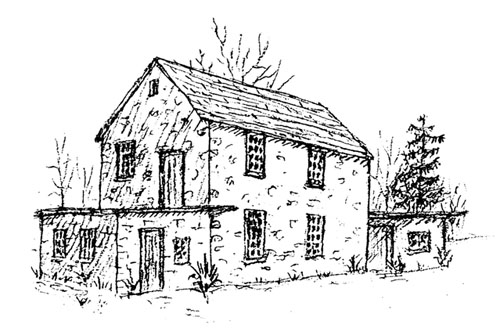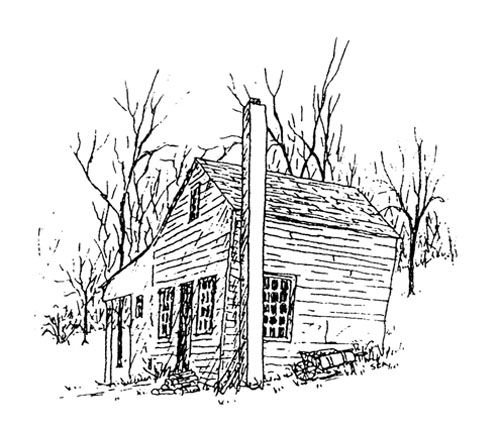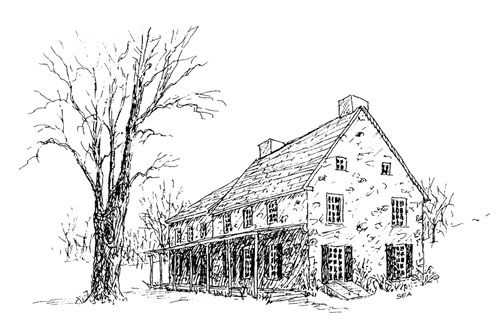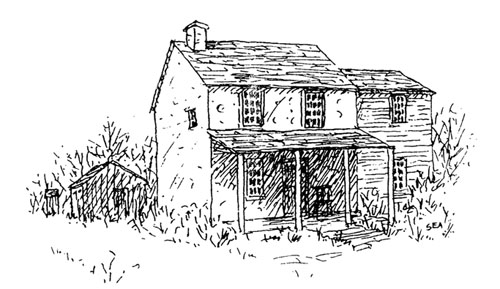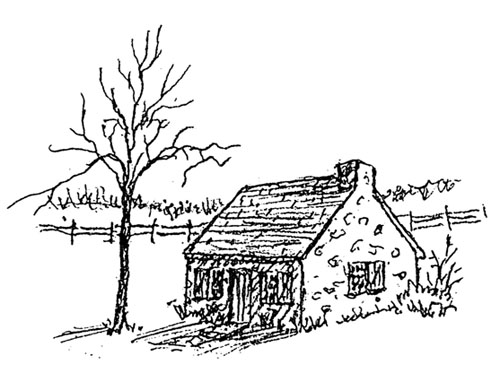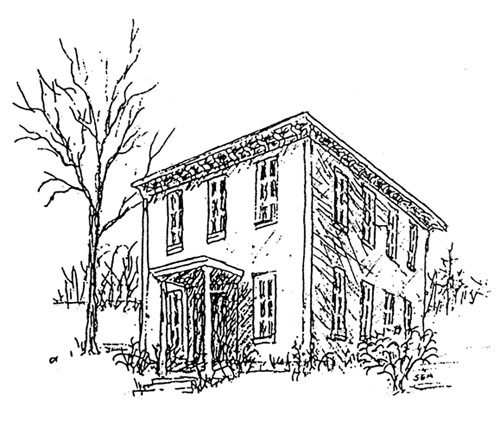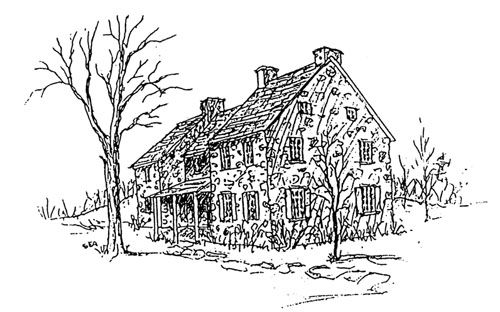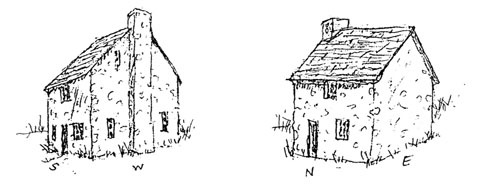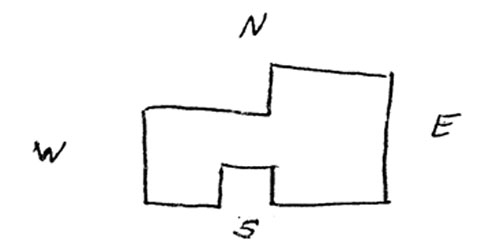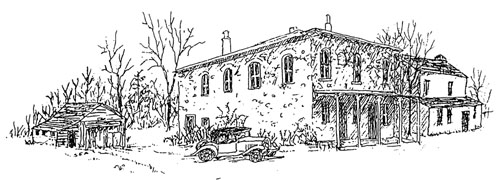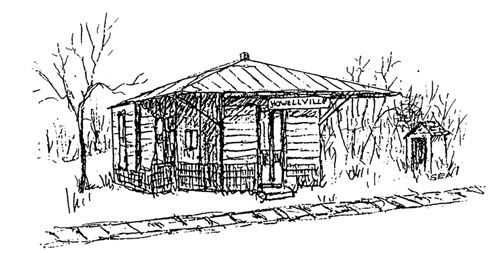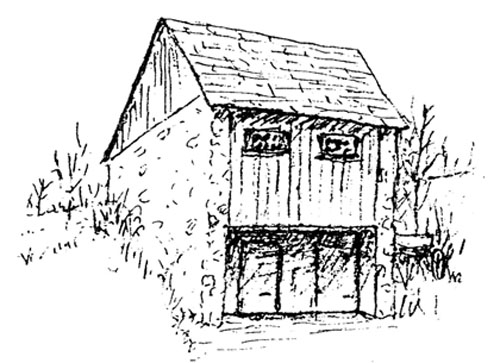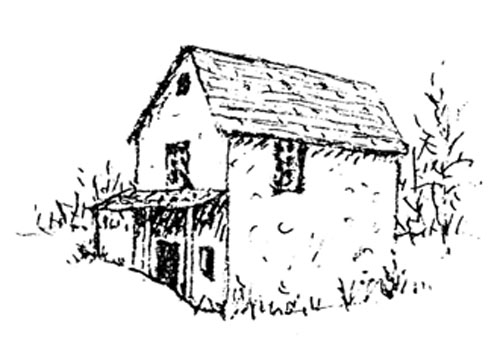|
Home : Quarterly Archives : Volume 39 |
Tredyffrin Easttown Historical Society |
|
Source: July 2002 Volume 39 Number 3, Pages 75–103 Howellville
THREE ROADS IN HOWELLVlLLE 1921 Howellville, one of Tredyffrin's earliest villages, grew in an area convenient to the farms of the Great Valley. A tavern was often the start of a town, and the first one here was built about 1712. By the early 1700s, sawmills and gristmills had appeared. Nearest to the center of town was the sawmill on Crabby Creek. Several of the early farms had their own limestone kilns. The first school opened about 1720. A factory of some kind belonging to the Workizer family is listed on the 1798 Direct Tax. [Note 1] By the late 18th century, a shoemaker and a wheelwright had set up shop. More industry developed in the 19th century, including a woolen mill owned by Samuel Wood. There was at least one blacksmith. By the middle of the century there was a store and the Chester Valley Railroad, and by the late 1800s Howellville was a thriving industrial town. The limestone quarries became big business and Italian immigrants arrived to work at them. Other nationalities followed, but were never as numerous or as prosperous as the Italians.
HOWELLVILLE
VIEW FROM DYER QUARRY ~ FACING EAST, BACK OF HOWELLVILLE INN WITH ROOF OF OLDER INN SHOWlNG. BEFORE 1920 By the early part of the 20th century, Howellville had become a close-knit community-a bit naughty, with lots of drinking and gambling. Then came the Depression which dealt rather harshly with the village. Having lost their jobs, and with no place to go, the quarry workers lived hand-to-mouth. In 1934 Frances Ligget, later a member of the Tredyffrin Easttown History Club, marshalled the help of the Valley Forge Farm and Garden Club to clean up the town and help the unemployed workers and their families. Free seeds were given for gardens. The state provided medical assistance as well as sewing, knitting, and cooking classes, and a nursery school. Weaving was taught by Lettie Esherick, wife of the artist Wharton Esherick. TopEARLY HISTORY In 1681 land in the center of Tredyffrin Township that would eventually become most of Howellville belonged to William Mordaunt and John Hort Each owned 500 acres. They were Welsh Tract brokers-they bought the land from William Penn but never lived on it. In 1711 Mordaunt's sons sold their 500 acres to John Evans, who had previously been Governor of Pennsylvania. Just to the east lay 1340 acres that David Meredith sold to William Powell in 1706. They were also Welsh Tract brokers. Llewellyn David, a Welshman and one of the early settlers, bought 300 acres in 1708. The name David (later changed to Davis) was the biggest name in Howellville for the next two centuries.
FACING WEST - TOWARD SWEDESFORD ROAD AND TRIANGLE MID 20TH CENTURY The area sat at the bottom of a natural bowl where three hilly roads met to form a triangle. Swedesford Road, forming the north side of the triangle, came into existence about 1720, very early in the settlement of the Great Chester Valley. It led from the vicinity of Randall Malin's house in East Whiteland to the Swede's Ford at the Schuylkill River, near present day Norristown, and gave settlers in the interior access to Philadelphia. Bear Hill Road, which formed the southeast side of the triangle, connected the Valley with the Black Bear Tavern at the top of the South Valley Hill near the Lancaster Road and today's village of Paoli. The southwest side of the triangle was Howellville Road, until a traffic light was installed at the corner about 1960. Then it became part of Swedesford Road and the north side of the triangle was made one-way. It was this way until most of Howellville's buildings were torn down and Route 202 was completed and dedicated in 1971. The triangle at the bottom of these roads was a convenient place for horses and wagons to stop and rest, and in 1745 a license was granted to establish the first tavern. When David Howell settled in the area and became the second innkeeper of the tavern, about 1765, it was called Howell's Tavern. The village that grew up around it became Howellville. When the old inn was razed in 1921, the only house in the triangle was the little house described by Henry Darling later in this article. The triangle disappeared in 1967 when Route 252 was widened and Route 202 was built.
DYER STONE CRUSHER 1912 Three main quarry companies operated in Howellville over the years. Early in the century, furthest west, where the Daylesford Lake community is now, was the John T. Dyer Quarry Co., established in 1912. By 1933 it was owned by E. J. Lavino Co., a shipping company. The Lavino Company owned many houses in Howellville, including two double houses that stood on Bear Hill Road on the way to Paoli. [Note 2] The company also owned and rented out the Coleman and Segui houses. The quarries where the Westlakes office park is now located were owned by Samuel Given between 1917 and 1926. Later they were owned by Ellis Johnson. The quarries always had problems with leaking water and had to be pumped out much of the time. The one that became most famous was owned by William Rennyson. In 1874 a 90-foot-long cave was discovered
LOOKING NORTH COLEMAN HOUSE
SEGUI HOUSE by workmen digging a siding for the Chester Valley Railroad. This caused a sensation-especially when a group of boys went into the cave and broke off many beautiful stalactites. The quarry mined marble as well as limestone. Late in the century William Rennyson decided to bottle and sell "Tredyffrin Water"-water that fizzed naturally because of the lime. Quarrying, no doubt, started on a commercial basis some years following the Revolutionary War. Hugh Steen, who leased the second Howellville Inn from John Workizer, also ran a quarry. This was in the late 1800s. The stone crusher was built sometime before 1897. It shows up on a map of this date. [Note 3] In the 1920s a big steel drum was built next to the crusher. It contained large steel balls, and when the limestone gravel was added, it turned and shook like a huge washing machine-grinding the gravel into powder. When these steel balls became too small for the job, they were used by the quarry workers to play bocce. They played in front of the tavern and all around the triangle.
DYER QUARRY OFFiCE
JOHNSON QUARRY OFFlCE AND APARTMENTS Shamrock Thornton's frame house stood on the southeast corner of Bear Hill and Howellville Roads. Today, widened Route 252 runs over the spot. Shamrock was the black engineer who ran the "switcher," a steam engine that transferred railroad cars of limestone between the quarry and the Chester Valley Railroad and the Trenton Cut-off.
SHAMROCK THORNTON HOUSE
FIRST HOWELLVILLE INN 1820 SECOND HOWELLVILLE INN 1712 The original Howellville Inn was inside the triangle, facing south.In 1777 British General Charles Grey was quartered there. According to a traditional story related by Mert Lemma, Washington's men took horseshoes, nails, iron tools, etc. from the blacksmith behind the tavern so the British couldn't use them. It was General Grey who ordered the flints removed from his soldier's muskets to surprise the Americans with a bayonet attack during the Paoli Massacre. The following description was written by Franklin Burns: The original Howell's tavern, with the apparent date of 1712, has long been in a dilapidated and untenanted state. The house, stable and blacksmith shop, all of stone, stood in a triangle formed by the Swedesford, Paoli and Berwyn roads. The tavern faced south, with a large crooked sycamore tree at the point of the angle. It was of three stories and had a double kitchen basement in which the living rock protruded. All rooms were furnished with open fireplaces and wall cupboards, and there had been a front gallery. Our local antiquarian, Reverend Dr. Quimby, called it the "King George III Inn." The early history of this hospitable building is lost in antiquity. Local tradition hints of a man killed in the barroom and buried in the cellar, and also that General Washington slept here one night, but offers no dates. An original settler, John David Howell, may have built it. Certainly a descendant, David Howell, kept a tavern here from 1768 to 1778, probably some years before, and farmed the 100 acres also. His widow Mary continued it from 1779 to 1781. Colonel Christian Workiser purchased it soon after and was landlord until his death in 1786. He was doubtless succeeded by his widow until her death in 1805, and for a period by John, their only surviving son, and heir of the Howellville property. John Workiser was a talented musician and gratuitously gave singing lessons and organized a singing school at his home. After a short residence as landlord, he leased the Howellville tavern and moved to the Mansion house at Valley Forge prior to 1816. The Howellville property was left to John Shiradin Workiser, son by his second wife. Christian Workiser's wife is recorded as a woman of great strength of character. During the British occupation of the Capitol, she walked all the way from Howellville to her brother's house in Philadelphia and returned with medicines and other prohibited necessities concealed in her pockets. She died Feburary 4, 1805 in her 55th year, and her body lies in the burial plot of the Old Eagle School, no doubt beside the unmarked grave of her husband. Her father gave the ground for public purposes, and her relatives erected a stone on which is inscribed . . . : "Verses on tombstones are but idly spent, The living character is the monument." [Note 4]
FIRST HOWELLVILLE INN In 1820 John Workizer, son of Christian, bought the first Howellville Inn, plus 63 acres, from Samuel Howell. He built the second Howellville Inn across the road (then Howellville Road, now Swedesford), probably by adding on to an existing building. [Note 5] The original Howellville Inn was torn down in 1921. If you are waiting on Swedesford Road at the present day traffic signal with Bear Hill Road to your right, with Howellville Road across the intersection, and Swedesford Road making a sharp left and becoming Route 252, you are on the very spot where the second Howellville Inn stood. Looking left toward King of Prussia, you can see how the road used to be a steep hill, but was leveled when they widened it. Virginia Boschi [Note 6] remembers when a big truck lost control coming down the hill and spilled a load of watermelons. Mert Lemma remembers this, and also a beer truck losing its beer all over the road. If you look sharply to the left you will see the old sycamore tree that stood in front of the first Howellville Inn. It has a circumference of at least 15 feet, and has been standing at least 135 years.
WORKIZER FARMHOUSE A farm of 59 acres belonged to Christian Workizer in the mid-1700s. In September 1777, British General James Agnew was quartered in the farmhouse. When Christian Workizer died in 1786 he owned nearly all of the site of Howellville, including the tavern. The farm passed to his wife and family. The farmhouse, occupied by John Workizer in 1798, was very large-it had 19 or 20 rooms. As well as the living quarters, the 1798 Direct Tax lists a one-story kitchen/factory 55 feet long by only 15 feet wide. We don't know what kind of a factory it was, but later it could have been incorporated into the house and made into two stories. The 30 x 18 foot house that is listed would have been the original house - with seven 12-pane windows. A springhouse 18 x 16 feet, and a log and stone barn 19 x 22 feet, are also listed.
WORKIZER HOUSE WITH KITCHEN/FACTORY When Christian Workizer's wife died in 1805, son John left the farm and bought a large property in Valley Forge that is now the restored Bake House near Washington's Headquarters. In 1883 it was the Mansion House Hotel. [Note 7] Christian Workizer's daughter Mary married John Wersler, and they lived in this farm until it was sold to William Hall in 1820 and to Joseph Williams in 1897. The house was owned by Joseph Williams until he died in 1901. Williams had ten children. In 1927 the Philadelphia Electric Company bought the property, and the house was lived in by Mr. Pea, a man from Tennessee who was hired to supervise the construction of the electric towers. Mr. Pea made moonshine. Mert Lemma tells the following story: One day some tough characters called on him and offered "protection" for a sum of money. Mr. Pea said he would pay them on Saturday. Meanwhile, he told police, who agreed to hide in the cornfield. On Saturday there was a shoot-out and the thugs drove away, their car riddled with bullet holes. Later, when they were caught, it turned out they were constables from Norristown. The Mitchell family lived in the Workizer house after Mr. Pea. According to Lemma, their two little boys, skating on the ice at the Johnson quarry, fell through and drowned. Their skeletons were found many years later by scuba divers and positively identified. Their parents had thought they had just "disappeared." The property was adjacent to John David Howell. This was the property later owned by John Supplee, and much later by the Philadelphia Electric Company. Supplee caused the sharp curve in Howellville Road when he would not allow it to come through his property. The photograph from which the sketch on page 84 was made shows the house facing the electrical tower just off the east side of Howellville Road. Tangled trees and bushes cover the area now.
HOWELLVILLE HOUSES STILL THERE The five old houses that remain on the east side of Howellville Road at the foot of the hill are an unusual block of houses. The land on which they stand belonged to Jacob Sheridan in 1767, and to Christian Workizer in the late 1700s. The first reference to any buildings is an 1819 Reid title search listing four tracts of land of almost forty acres with "messuages, tenements, water corn or grist mill." [Note 8] One lot contained a mill dam. The entire property was sold by Cromwell Pearce, sheriff, to James Hunt. After some short-term owners, John Jones owned it from 1827 to the late 1870s. An 1847 map [Note 9] shows a woolen factory on the west side of Howellville Road just south of the triangle. Samuel Wood and his son owned it until 1880. Samuel Wood, Jr. sold it to Isaac W. Smith, whose name does not appear in the 1883 Breou atlas. [Note 10] In 1909 Angelo Meoli bought the property from Isaac Smith. The houses standing today were probably built at various times around the middle of the 19th century. Their original occupants were quarry families who rented them. A 1912 map [Note 11] shows Hugh J. Steen (probably his estate) owning the upper three houses and sixteen acres. Manor Real
1847
BREOU ATLAS MAP 1883 Estate & Trust Company, a unit of the Pennsylvania Railroad, is shown owning the double house in the middle, and possibly the Odd Fellows Hall directly across Howellville Road.
HOWELLVILLE 1912 The 1912 map also shows Angelo Meoli owning the house and four acres on the west side of Howellville Road. The house still belongs to the Meoli family. Dominic Meoli's daughter Martina wrote the following narrative -Angelo Meoli was her great grandfather: In 1897, Mr. Angelo Meoli and his wife Rosaria, originally of the Benevento region of Italy, purchased a 2O-acre farm called "Rosewood" in Howellville, Pennsylvania. The house was originally built in 1844. In this house Mr. Meoli and his wife raised 5 children-Nick, Peter, Annette, Mary & Bridget. As the children married, Mr. Meoli built each one a house on the farm. Angeio Meoli and his wife operated a general store within the house. The store sold provisions such as buttons, fruit, bread, jars and lids, etc. It was similar to a five and dime store. Nick Meoli had a store that originally served ice cream and groceries in the Odd Fellows Hall. He later moved the business across the street to the corner of Route 252 and Howellville Road. Mary Meoli married Antonio "Cruise" Bozzi, and Bridget Meoli married Anthony Rubbo. The brothers-in- law, who both worked in Sam Given's quarry, could not stand each other. They would often gather with the other Italian men in the neighborhood, but would never speak to each other. Annette Meoli married Salvatore Romano and had three sons and a daughter. The children all resided, or still reside, in Howellville. Approximately ten years ago, the daughter, Anna, sold her land to the Southpoint development company, who erected office buildings on it. The homes are all currently rented. Peter Meoli stayed on at the main residence after Angelo passed on in 1939 at the age of 75. Peter and Victoria, his wife, maintained the small store at 1057 Howellville Road for a number of years, which sold groceries and meats besides some small five and dime items. Peter Meoli made an incredible Italian sausage, and he eventually gave the recipe to Maggio Brothers of Norristown who, in turn, are still in business and still making a profit from his secret recipe. Peter Meoli also sold property to Algar, who had erected a high-end car dealership on the land. Eventually Peter became too ill to run the store, and he passed the business on to his son Dominic, who turned it into a wholesale meat company that is still operating from that location today. Dominic and his wife, Dolores, still live in the original farmhouse. The original farmhouse had a hidden staircase, along with hidden treasures buried behind its walls that were uncovered in 1981 during a remodeling phase. The treasures included such family heirlooms as pictures, relics, collector bottles, jewelry, and old coins. The original farm had a barn and corn crib. Although it was used mainly to raise cattle and pigs, it also grew corn for animal feed between 1889 and 1927. In 1974 the barn roof collapsed, ending the farming venture. In 1980-81, massive efforts were made to change the original terraced landscape of the farm to a subtle hill-scape. The Meoli family of Howellville practiced many of the Italian customs. The families grew grapes and produced their own wine, a tradition that has been passed on through the generations to today. As a matter of fact, Angelo's original wine press was used just recently to make this year's home wine allotment. Cooking and eating, though, remain the biggest pastime, and many of the recipes have been handed down to today's generation. [Note 12] At present, the two northern-most, or lower, houses belong to Bob "Mex" Barajas, who also owns the old house and barber shop across the road. The upper three houses are now owned by Mrs. Joseph Romano, whose mother-in-law was a Meoli. The Romano family owns the land to the south where they have a landscaping service.
BLUE STONE FARM Blue Stone Farm, named by Ellis Johnson (it had always been the Davis farm), and now the Westlakes office park, was part of the 300 acres belonging to Llewellyn David. In 1734 it was handed down to Isaac David, and then to Benjamin Davis (the family changed their name from David to Davis in 1779). The farm, and later the quarries, remained in the Davis family for over two centuries. The 1798 Direct Tax lists a farm of 160 acres, a stone house 30 x 21 feet, a large, outside kitchen 30 x 17 feet, a springhouse 14 x 12 feet, and two barns 60 x 28 feet and 48 x 25 feet-all stone. Also listed is one- half of a double-geared sawmill. Its ruin can still be seen at Westlakes. The other half must have belonged to a neighbor. According to Franklin Burns, there was a still for making rye whiskey on the Davis farm just below Howell's Tavern. The following is based on an interview with Ruth Wynn, niece of Samuel and Emily Given, who lived on the farm until it was sold to Ellis Johnson in 1926: Sam Given was into drink and horses. He owned the two quarries east of Swedesford Road. Somehow Johnson suddenly got the quarries, the farmhouse, and contents. Given's mother had to move. One of the mother's husbands was Lovett. While Sam ran the quarries his arms were blown off. His wife did the bookkeeping and chauffeured him while Sam continued to run the quarries. The accident blinded another man. He sold pencils under the arch on the way to Philadelphia. When Given's niece was growing up she walked from her grandmother's house over a bridge toward Norristown. She picked wild mushrooms and wild asparagus. She was on her way to get milk. The niece, Ruth Wynn, lived with her parents on the hill towards Berwyn. The farm, now known as the Philadelphia Electric [PECO] farm, was first known as the Workizer farm. It had 19 to 20 rooms and an electric tower in the front yard. The farm raised enough vegetables and eggs to supply Pete Meoli's store in Howellville. He was a butcher. Still, times were hard. One severe winter the family burned the furniture to stay warm. The father had left by this time. The railroad engineer spotted Ruth and her siblings picking up pieces of coal on a steep grade somewhere near Paoli/Berwyn. The engineer frequently afterwards stopped the train and shoveled coal off his cars. Ruth and her siblings collected the coal in baskets. Ruth's mother went to work for J. Bishop and Co. making medical needles, etc. for the war. She walked to where Boston Chicken is now, and then got a ride to Malvern. When Ruth's brother was around 10 or 11 years old, he quit school and worked for a news agency. Ruth remembers a black family near Matthews Ford, whose daughter was Ruth's teacher. Finally PECO sold the farm. Ruth's family moved to a double house, now MFS&L, in Paoli. The other side was owned by Germans. Ruth and her siblings told her mother they heard German spoken in the basement. The war had started. They were spies operating a radio in the basement of their side of the house. It was written up in the Daily Local News or the Philadelphia paper. Ruth's side of the house caught on fire. It was heated by wood. No one wanted to buy the German's side because they were afraid of fire. Ruth's family moved in until their side was rebuilt A note on the third quarry on the other side of Swedesford now filled with houses: During quarrying a big spring was hit. The quarry filled with water so quickly there was not enough time to get equipment out. Also, behind the barber shop was a swimming hole. [Note 13] Ellis Johnson bought the rest of Blue Stone Farm from John W. Davis, who had inherited it at the time he bought the Given's property. He ran and enlarged the quarries, and also raised racing horses. In 1965 he sold the farm and quarries to the Warner Company. The big house was rented for a short time until it burned to the ground in 1974.
JOHN DAVIS HOUSE - STILL THERE Mert Lemma remembers, 80 years ago, sitting on the fence at John Davis' house, just north of the triangle on Swedesford Road, and watching the games that Davis organized in the field next to his house (and store). They played baseball, and had raffles pigeon shoots. A local historian was told by John Davis that his house, which had a soft drink stand, was built by Davis' ancestors many years before as a blacksmith shop. At the time, John Davis, said Mert, was the unofficial mayor of Howellville. The house is still there, and is lived in by a Davis descendant, Matilda Navarro Butcher. Her great, great grandparents were Albert K. and Matilda T. Davis, who owned Blue Stone Farm in the late 1800s. Their son, John M. Davis, who never married, inherited the farm, and in 1917 sold part of it and the quarries to Samuel and Emily Given. Matilda Navarro and her sister Justine were children when Blue Stone Farm was deserted. They enjoyed playing in the fields around it. Now Matilda lives in the same house with her husband Roy Butcher. She showed me The Society of the Cincinnati medal-a beautiful gold eagle- that her direct ancestor John Morton was given by George Washington. [Note 14] John Morton was a signer of the Declaration of Independence. His daughter, Ana, married John Davis (1753-1827), a Captain in Anthony Wayne's company during the Revolutionary War. He was the grandson of the original Howellville settler, Llewellyn David (later changed to Davis). His property became Blue Stone Farm. He is the John Davis listed in the 1798 Direct Tax.
OLD HOUSE IN THE TRIANGLE This little house stood in the triangle at Howellville for many years. The following is from journalist Henry Darling in 1964. This little house by the side of the road looks as if it would much rather be elsewhere. And you can hardly blame it. Heavy traffic going north from Paoli thunders down a steep hill and around a bend in Route 202 just a few feet away. Trailer trucks, buses, automobiles roar by all day long. It's enough to make anybody almost fall over backward. There are other houses in Howellville. All are old. Some date back to the Revolutionary War. One was headquarters for a British general. But none has the distinguished list-nor the varied history-that this one has. Peter Meoli, a longtime resident of Howellville, said the tipsy little building is about 100 years old. He said it was a saddler's shop around the turn of the century, and for the next decade or two was a barbershop operated at different times by four barbers named, consecutively, Big Ben, Looie, Joe and George. "When I was a kid about 40 years ago," Meoli said, "a blacksmith named George lived in it. He used to shoe the mules and do iron work in the old quarry." After the blacksmith left, the leaning house of Howellville became a store, then a church, then a poolhall (there's just room in it for one table), then a home for an elderly couple who grew tomatoes in the backyard, Part of it is clapboard and part stone. There's a tiny room upstairs which can be reached only by climbing over the back shed roof. Meoli said no one seems to know what made it tilt like that. "It's been that way as long as I can remember," he said. "Maybe the ground settled under it or maybe part of the foundation gave way." Howellville is in limestone country. Limestone sometimes erodes away, leaving an underground hole which can cave in-suddenly or over a period of years. Or maybe it was built by a man who didn't own a level. One thing is certain. The chimney was built after the little house assumed the angle. The chimney raises straight and true from ground to rooftree. [Note 15] Bobby "Mex" Barajas was born in the tiny room "upstairs." Also in the triangle, just a little north of the crooked house, were the ruins of a blacksmith shop. It was already in ruins when two children were murdered there on March 14, 1905: Two helpless and innocent children were outraged and murdered by an inhuman brute. The little girl, Rosie DeLucca, only four years of age, was either induced to enter an old blacksmith shop or was already at play there with her [10 year old] brother, Dominick DeLucca, when the assailant entered soon after 7 o'clock on Tuesday evening last. Just what was done in the few horrible minutes that followed only those three saw, and the lips of the children are closed in death. Enough is known, however, to establish the fact that a fiendish assault was committed upon the helpless little girl, and that her little brother rushed bravely to battle for her rescue. There could be but one issue to such a struggle. Both children are dead .... The old blacksmith shop was once a scene of busy industry, but has for several years past been abandoned, and is said to have been used as a play house and common place of resort by the children of the Italian families in the neighborhood. [Note 16]
The murderer was apprehended and hanged in the Chester County prison. Mert Lemma says it was the last hanging in the county.
RHINEWALT HOUSE (UPSTREAM FARM) Upstream Farm was also known as the W. W. Davis property. It had belonged to the Davis family for a few generations in the late 1800s. Originally it was part of the 600 acres that belonged to Thomas James in 1720, and then to his son, Lewis James, until 1753. Late in the 1700s it belonged to Henry Zook. From 1800 to 1836 it belonged to Adam Rhinewalt (my great, great, great grandfather). The following obituary is for Adam's daughter, Sarah Rhinewalt Wells, who died about 1880. It gives a picture of life in Howellville in the early 19th century. Mrs. Sarah Wells of White Hall, Montour County, Penna., died on Tuesday, 13th inst., at age of 77 years and was buried on last Tuesday. Mrs. Wells was the daughter of Adam Rhinewalt, who for many years lived near Howelville [sic], this county, on the farm now owned by W. W. Davis, Esq. Mr. Rhinewalt was a very popular man in his neighborhood, and the family were particularly noted for their social qualities and generous hospitality ... . Mr. Rhinewalt, the father, was very deaf, and at an old age was accidentally killed by the cars while walking on the Reading R.R. About the years 1825 to 1835, while residing in Chester Valley, there was probably no family in Chester County better known or more highly respected than that of the Rhinewalts. Many people yet living within our borders can testify to the cordial greeting and generous treatment received from their hands while visiting their homestead. The "latch string" of their door was always hanging out, and many a sleighing or other social party made their home the object of their visit. Sarah was always the leading spirit at these gatherings, and by her pleasant manners and extreme cordiality won the affection and esteem of the community. Being married in the later years of her life, she retained to a great degree her old and well-known name of "Sallie Rhinewalt." By the younger portion of her friends, and the children of her old and familiar acquaintances, she was universally known as "Aunt Sallie Rhinewalt." She was an exceedingly fine conversationalist; well informed on all the topics of the day; a Christian women, and a pleasant companion. [Note 17] The house still exists, and is now very close to Swedesford Road off of Duportail Road. Before Swedesford Road was moved in 1967, it had a long driveway going south almost to the railroad overpass. It was severely burned in the early 20th century, and has been restored and added to over the years. The early 20th century owner Ernest Scott began the restoration, and probably was the one who named it Upstream Farm. The house is listed under Henry Zook in the 1798 Direct Tax as being 21 x 19 feet with only six windows. The part of the house to the west-that burned most severely-is most likely the original house. The large stone barn, which still stands, measured 63 x 30 feet. John Morton Davis acquired the property in 1842, and his son William Wally Davis owned it from 1865 to 1881. Ellwood Jaquette owned it until 1898 when it was bought by A. J. Cassatt, who already owned most of Chesterbrook. It was called "The Squire's House" because Cassatt stayed there when he visited from his home in Haverford.
RHINEWALT TENANT HOUSE The tenant house was much closer to Swedesford Road, and may have been the original house on the property. It was added to over the years, and owned by Edith Parker when it was demolished in the spring of 1967 for Route 202 to come through.
FIRST HOWELLVILLE SCHOOL
2ND HOWELLVlLLE SCHOOL BURNED DOWN IN 1922 The first Howellville school was built in 1720 on land donated-it was really rented for 999 years- by the Davis family. For this reason it was some times called the Davis School. General Davis, the donor, was the grandfather of William Wally Davis. It was torn down in 1810 and replaced by a second school, which was remodeled some time later. Both schools were north of Swedesford Road east of the village. The second school burned in 1922. Mert Lemma remembered that when the schoolhouse burned, some people blamed Sam Given, saying he wanted to enlarge his quarry which was next to the school.
DETWILER HOUSE - RAZED 1927 The Detwiler house, southeast of the village, was just east of the Joseph Williams property, and was originally part of the 300 acres that John David bought from David Powell in 1709. It left the David family in 1769, and was bought by Valentine Showalter who sold it to John Detwiler in 1783. Jacob Detwiler inherited it in 1795. The house was built in three sections. The largest, on the eastern end, was the most recent. The other western end was the original house, and was listed in the 1798 Direct Tax as being a two story stone house 20 x 30 feet. It had four 9 pane windows, and four with only 3 panes-both very unusual.
1798 DETWILER HOUSE (POSSIBLY) A plot plan made in 1918 for owner Annie Wertz Miller indicates an odd shape. When the large eastern part was built, the owners probably used the original house as an outside kitchen and sometime later built the section in between:
PLAN OF DETWILER HOUSE Many old houses still existing were built this way. The most recent wing on the eastern end was built around 1830 by Jacob Detwiler. At the same time his son, Henry, bought our farm a few miles away on Yellow Springs Road, and built a large wing on the western end which is very similar to the one built by his father. After Jacob Detwiler died in 1848, his property changed hands several times. In 1875 it was bought by William Rennyson, who had several quarries, an unsuccessful surgical supply company, and "Tredyffrin Water." Captain Rennyson built a mansion that is still standing and is now owned by the Aquilante family. He used the Detwiler place as a boarding house for his single employees.
ODD FELLOWS HALL The Odd Fellows Hall, across Howellville Road from the block of houses to the west, was built in 1848 by Hugh Steen. (Before this time the Odd Fellows met in a small stone building on Old Lancaster Road in Berwyn known as the Paoli Lodge.) The Hall was on the second floor. The ground floor was usually a store, and sometimes it was the post office. It was known as the Chester Valley Post Office. A Chester Valley postmark is rare and could be valuable. When the Howellville School burned down in 1922, the second floor of the Odd Fellows Hall was used as the school for several years. Canby Smith became the first postmaster in 1857. He also ran the store. A number of postmasters followed, most of whom were also storekeepers. In 1872 Hugh Steen, then tavemkeeper of the second Howellville Inn, bought the store and became the postmaster. Steen lived in Howellville at two different times. As a young man in his late twenties, he was at the first Inn. Then, when he was in his 50s, he returned to the village to manage the second Inn. In 1886 James Todd took over both jobs for three years. Then Hugh Steen's son-in-law, John Beitler, Jr., became postmaster and storekeeper until 1894. The following newspaper article explains what happened: For years John Beitler, of Howellville, Tredyffrin Township, was regarded as an excellent citizen. He stood in well with the politicians, and was supposed to be doing a lucrative business in the general store that he owned. There are [a] large number of Italians working the vicinity of Howellville, who after every pay day sent money to their folks in sunny Italy by means of money orders. Recently these money orders have ceased to pass through the New York office, and the authorities suspicion [sic] that something was wrong and detailed an Inspector to look into the matter. He found that while Postmaster Beitler gave receipts to the Italians, he did not send the money but put it in his own pocket. On Friday he visited his sister Mrs. Lizzie Smedley, of this place, and early Saturday morning he left for parts unknown. Before leaving, he borrowed money from many friends. Harrison Rennard is out $300 and Chas. Greeves $200. The Italians are angry, and it would not be safe for Mr. Beitler to return home just at present. On Monday, Hugh J. Steen, Beitler's father-in-law, entered judgement on his property for $10,000. Mrs. Beitler thinks that her husband has committed suicide and wants the reservoir dragged. Searching parties visited the reservoir, and Lake in the Woods on Wednesday, but found nothing to indicate that Beitler had visited either place. [Note 18] In 1894 Ella Pedrick became postmistress and moved the post office into her own home next door. In 1897 the post office was moved to the tiny Howellville station of the Chester Valley Railroad.
HOWELLVILLE R.R. STATION AND POST OFFICE Several more postmasters had the job until 1906 when it was closed for good. From then on, mail was processed in Berwyn. TopNOTES 1 A tax that was never enforced but has become a treasure for historians. It gives information about t he buildings on a property -including dimensions, material (stone, log, etc.), the number of windows and windowpanes, and acreage and names of adjacent farm owners. It is also known as the 1798 Glass Tax. 2 Interview with Mert Lemma (20 Berkeley Road, Devon, Pennsylvania) by Sue Andrews, October 29, 2001. Mert was born in 1916 in the northern end of the Howellville Inn which had been converted into apartments. His father worked for the Lavino quarry where his job was to tend the stone crusher. 3 Atlas of Surveys Along the Une of the Pennsylvania Railroad. Philadelphia: Mueller, 1897. 4 Franklin L Burns. Unpublished manuscript. c l930. In the files of the Tredyffrin-Easttown History Club. 5 Because of an article in the Main Line Times (August 23, 1951) by John M. Nugent, some people believe that the second Howellville Inn was the only one. Its picture is in the article. The stories are, I'm sure, true but where they happened was in the old inn across Swedesford Road inside the triangle. Several sources confirm this: Franklin L. Burns, "The Invasion of Tredyffrin: A Local Cross -Section of British Aggression During the American Revolution," Tredyffrin Easttown History Club Quarterly, vol. 3, no. 2 (April 1940), p. 41; [Howellville Inn photograph, 1912], L. Carstairs Pierce Collection, Chester County Historical Society, West Chester, Pennsylvania; Franklin Burns cited in several places throughout this article. 6 Interview with Virginia DiMonte Boschi by Sue Andrews, Fall 2001. Virginia was born in 1927 in the house that Ellis Johnson built for her family. Her father was a good friend of the Johnsons, and was his crane operator in the quarry. 7 J. Smith Futhey and Gilbert Cope. "Workizer, Christian." History of Chester County, Pennsylvania with Genealogical and Biographical Sketches. Philadelphia: Louis M. Everts, 1881. p. 773 8 Reid-Gordon title search, number 1368. Chester County Historical Society, West Chester, Pennsylvania. 9 Unsourced map of Tredyffrin Township mounted with other township maps. Library clipping file under Tredyffrin Township, Maps. Chester County Historical Society, West Chester, Pennsylvania. 10 Breou's Official Series of Farm Maps, Chester County, Pennsylvania. Philadelphia: W. H. Kirk & Co., 1883. p. 204. 11 Atlas of the Properties on the Main Line Pennsylvania Railroad from Devon to Downingtown and West Chester, Embracing Boroughs of Downingtown, Malvern and West Chester, and Easttown, East Bradford, East CaLn, East Goshen, East Whiteland, Newtown, Thornbury, Tredyffrin, Upper Merion, Westtown, West Goshen, West Whiteland and WilIistown Townships, Compiled from Actual Surveys, Official Records and Private Plans, by J M. Lathrop and St. Julian Ogier, Civil Engineers under the Direct Supervision and Management of A. H. Mueller, Publisher, 530 Locust Street, Philadelphia, Pa. Philadelphia: Mueller, 1912. plate 7. 12 Information supplied by Martina Meoli Molsbergen, March 2002. 13 lnterview with Ruth Wynn (197 Summit Road, Malvern, Pennsylvania) by Sheila Kellogg, Summer 2001. 14 Interview with Matilda Navarro Butcher by Sue Andrews, January 2002. Matilda still lives in Howellville in the John Davis house. 15 Henry R. Darling, "Old Howellville House," The Evening Bulletin (March 5, 1964), p. 6. One of a series of Henry Darling's "Post Cards" published in The Evening Bulletin. 16 "Story of the Crime," Daily Local News (March 17, 1905). Newspaper clipping file folder for the Delucca family. Chester County Historical Society, West Chester, Pennsylvania. 17"Death of Aunt Sallie Rhinewalt," undated clipping from unidentified newspaper, in Catharine Rhinewalt Supplee's Bible which she received in 1868 from Robert I. Evans. Owned in 2002 by Sue Andrews, 1700 Indian Run Road, Malvern, PA 19355. 18,!A Tredyffrin Sensation. Postmaster John Beitler Skips Out by the Light of the Moon and Leaves a Number of Sorrowing Creditors," Chester County Democrat (February 8, 1894).
ONE OF MANY BARNS AROUND HOWELLVILLE
LITTLE HOUSE AT UPSTREAM FARM Text and illustrations © Copyright 2002 by Sue Andrews |
